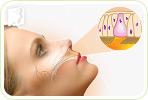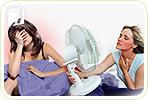Night sweats and chills are menopause symptoms that - surprisingly – go hand in hand. During perimenopause - the years just prior to menopause - changes in hormone levels cause imbalances to occur in a woman's body. This can cause temperature increases at seemingly random moments, to which the body responds by producing sweat to cool down. Once the body has regained a more consistent and normal temperature, chills might occur as body temperature continues to decline. These temperature changes can make it difficult for perimenopausal women to experience restful sleep.
Temperature Triggers
While the cause of extreme temperature changes during menopause is primarily hormonal, environmental, dietary, and lifestyle factors often contribute and trigger the symptom. For example, exercise raises body temperature and can trigger sweating episodes for up to two hours afterwards, which means that after a woman already prone to temperature change works out in the evening, she is more likely to experience chills later that night.
Combating Night Sweats and Chills
The most effective way to combat both night sweats and chills is by aiming to achieve a consistently cool internal body temperature. This advice may sound obvious, but avoiding heated environments - such as baths, saunas, and hot tubs - in the evening, and resisting drinking a hot beverage directly before going to bed will go a long way in promoting restful sleep. Dietary triggers, such as alcohol, spicy foods, and caffeine can also induce sweating, so consider limiting or completely cutting these from your evening diet, too.
Try not to allow your body to get too cold in the evening in your attempts to keep cool, as this may trigger chills. Sipping a glass of cold water and wearing breathable cotton nightwear should be enough to keep your body temperature down without becoming too cold.
Creating a Healthy Sleeping Environment
Creating a sleeping environment that's conducive to restful sleep is one of the most important factors when dealing with sweats and chills. It is important for the room to be cool and ventilated, but not too cold; avoid using central heating in your bedroom and keep a window open, but layer plenty of cotton sheets over your bed to sleep beneath to keep you warm, as these are breathable and easily kicked off if necessary.
When a woman is in her forties and early fifties, night sweats and chills are usually associated with menopause, and are most effectively dealt with through a series of dietary, lifestyle, and environmental adjustments. If you notice other worrying symptoms alongside sudden temperature change, however, it is advisable to consult with your doctor to rule out serious medical concerns.
Sources
- Dall, L. & Stanford, J.F. (1990). Fever, Chills, and Night Sweats. In: Clinical Methods: The History, Physical, and Laboratory Examinations. 3rd ed. Boston: Butterworths. Retrieved April 29, 2014, from http://www.ncbi.nlm.nih.gov/books/NBK324/
- National Health Service UK. (2012). Night sweats. Retrieved April 29, 2014, from http://www.nhs.uk/conditions/night-sweats/Pages/Introduction.aspx
- National Institutes of Health. (2011). Sweating: MedlinePlus Medical Encyclopedia. Retrieved April 29, 2014, from http://www.nlm.nih.gov/medlineplus/ency/article/003218.htm
- Stanford University. (1998). Sleep Hyperhidrosis (night sweats, excessive sweating). Retrieved April 29, 2014, from http://www.stanford.edu/~dement/sweats.html




